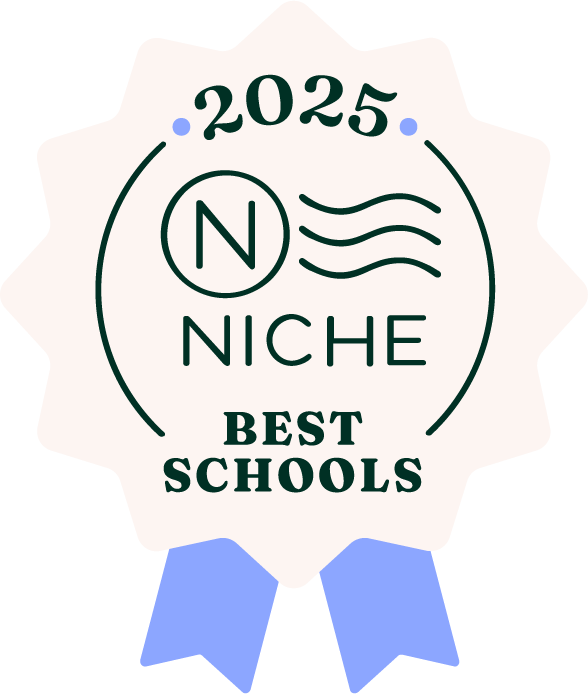Dear Friends,
A very Happy 2019 to you all! I wanted to send a personal note of thanks to each and every one of you for your contributions to our School. Whether you donate your time, your talent, or your treasure, every gesture is appreciated and celebrated.
As our children are busy doing their important work in their classes, the GMSCA is also doing our important work cultivating and supporting a vibrant and engaged parent community. Looking ahead, we will have many opportunities to get together to support our children, our faculty, and each other. Keep a look out for these upcoming events - we hope you'll find there's something for everyone!
- No matter how old your children are, everyone is welcome to attend any of our School's extraordinary stage productions. Upper Elementary just produced and performed "Back to Families Feudal," the 17th annual Fare Faire. Primary students will take center stage for their Winter Singalong on Friday, February 8 at 9 a.m., and Lower Elementary will celebrate customs from around the world in their Festival of Lights on Tuesday, March 5 at 6:30 p.m.
- On Friday, February 1, join us in the Gym from 4 to 7 p.m. for our second annual community volleyball tournament. Parents vs. staff vs. alumni vs. students will compete to see whose volleyball skills reign supreme..
- The GMSCA Basketball Jam is Saturday, February 9 from 9 to 11 a.m. This family-friendly event will offer plenty of games for kids, a three-point contest for adults, snacks for the whole family, and more.
- Later in February, we'll invite you to donate snacks for our teachers to enjoy between their parent-teacher conferences on Thursday, March 7 and Friday, March 8.
- Our next GMSCA Family Dinner is Monday, March 11. Join us anytime from 5 to 7:30 p.m. for a a casual, family-friendly dinner together at Cugino Forno.
- The Spring Community Garden Workday is on the books for Saturday, April 6 at 9 a.m. Come one, come all and enjoy the beauty, fun, and flavors of our blooming gardens.
- Join your fellow parents for a night out at the Green & White Bash on Saturday, April 13 in the Gym. This annual gala and silent auction promises to be a night to remember!
See you in our community, whether we're enjoying a student performance at school or breaking bread together at a local restaurant!
Karen Kelly,
GMSCA Lead Coordinator
To have Greensboro Montessori School's academic calendar (and other school events) automatically sync with your personal calendar, subscribe to our school calendar. To ensure you the most relevant events to your family get pushed to your calendar, we encourage you to customize your subscription based your child's division.
- Visit our online calendar.
- Find the "Categories" filter sitting on the left side, just above the calendar.
- Use the drop-down menu to select your child's division.
- For Toddler, please find and select your child's specific classroom.
- If your have children enrolled in more than one division, please select all applicable divisions.
- Select "GMS Athletics" to also subscribe to the Panthers' game schedule.
- Scroll down to the bottom right corner and click "Subscribe to filtered calendar."
- Select your desired calendar app, and follow the remaining prompts to complete your subscription to the GMS calendar.
On Friday, October 26, 2018, Greensboro Montessori's head of school, Dr. Kevin Navarro, received a formal notice of retirement from the School's bus. Seeing as the bus is a valued member of the team with over 19 years of service to the School, we felt it appropriate to share its retirement letter with the entire community. The letter is reprinted below (with the bus' permission, of course).
Dear Dr. Navarro,
I love everything about Greensboro Montessori School. The way every child is empowered to have a real voice and real agency. The way students learn how to apply their academic skills in intentional and authentic ways. And the way students learn to work and wrestle with, understand, and clearly articulate complex ideas.
However, I think we both know, it’s time for a change. I humbly request you accept this letter as my formal notice of retirement effective December 31, 2018.
Words will never fully express the gratitude I feel for the purpose-filled career Greensboro Montessori School has given me. During my 19 years at the School, I've been on many adventures throughout the state, including the Wright Brothers National Memorial, the International Civil Rights Center & Museum, and Roanoke Island Festival Park. Many years ago I took the faculty to Florida for an American Montessori Society (AMS) Conference. I know the way to the School’s Land campus in Oak Ridge by heart, and I've been to hundreds of Panther sporting events.
What I treasure most is the miles I've logged with over 500 different students. I know them each by name. I've laughed at their jokes, been in on their secrets, and love their playlists! My greatest honor has been watching them grow from toddlers (when they didn't even know I existed) to teens (when they sometimes treated me as if I didn't exist). No matter what, it has been a journey of love.
I hope you know I am proud of what I've achieved. I wish I could work forever, but truth be told, I'm getting a bit tired:
- My pickup and acceleration just aren’t what they used to be;
- I’ve worn through two complete sets of tires;
- Five years ago, I had to have both my ball joints and tie rods replaced;
- My air conditioning was overhauled 10 years ago;
- It really hurt when my alternator was cross-threaded six years ago;
- And it was just down right embarrassing when I broke down in Durham last summer with antifreeze issues, and a tow truck had to carry me home.
It’s time. We both know it is, and I’m sure you will find a great replacement to honor the incredible work you do with our students. I look forward to fulfilling my duties through the end of the year and will gladly help you and the team find my replacement. Depending on the expediency of your search, I may also be available for some consulting in the spring. In the meantime, if there's anything else you need, please let me know. When not working, I'm usually resting in the grassy lot on campus.
All my best and all my love,
The GMS School Bus
To my fellow GMS Families,
Welcome to the 2018-19 school year!
The Greensboro Montessori School Community Association (GMSCA) is excited and honored to welcome families joining our school community for the first time. We’re also proud to welcome back our returning families for another wonderful year at GMS!
Our hope is that every family will find value in the GMSCA. Our mission is focused on building and sustaining community. More specifically, "the GMSCA is a dynamic, inclusive organization that strives to enrich the school experience for all. We foster a vibrant school community, and serve to bridge and connect home and school while supporting the mission and goals of Greensboro Montessori School."
Unlike many public and private schools, membership in the GMSCA is automatic and free! We don't ask for or require dues. Nor do we ask you or your children to sell anything. Instead, our activities are funded through other ways, with our primary source of income being the School's fall and spring Scholastic Book Fairs. We also raise funds through initiatives like Harris Teeter's Together in Education (link your VIC card to #1849), General Mills' Box Tops for Education, and AmazonSmile.
The most visible way you will see the GMSCA in action is through GMSCA-sponsored events, teacher appreciation initiatives, and community volunteering.
- Events: The largest event we plan every year is the Fall Festival, a family-centered Sunday afternoon featuring dozens of activities for our entire student population. (Don't miss this year's event on Sunday, October 14 from 2 to 5 p.m.) We also organize the School's International Fair, an annual celebration our community’s cultural diversity through music, food, art, and fun. We also host coffee socials on campus and community gatherings at local businesses.
- Teacher Support and Appreciation: The GMSCA supports designated room parents who work directly with your teachers and help coordinate other parent volunteers needed to plan and execute many of the fun and educational activities our students love. Throughout the year, we also provide organized opportunities through which families can express appreciation for our professional educators.
- Community Volunteering: Our School partners with BackPack Beginnings to help fulfill this local nonprofit's mission: to deliver child-centric services to feed, comfort and clothe children in need. In addition to coordinating food drives, we also sponsor Peeler Open Elementary. Parent volunteers make weekly deliveries to Peeler students who need child-friendly, nutritious food to fill the weekend food gap.
We invite you to connect with us. Whether you join our private Facebook group, volunteer at the Fall Festival (details coming later this month), or contribute in your own way, we appreciate every gesture of kindness and community-building. Most importantly, know you don’t need to attend a meeting, host an event, or take a day off work to volunteer to be an essential member of our school community.
We’re looking forward to an amazing 2018-19 for our School, our families and, most of all, our children.
See you at school!
Cordially,
GMSCA Lead Coordinator
2017-18 has been a fantastic year at Greensboro Montessori School, and we very much appreciate the students, families, and teammates who have been part of our community. Looking back on our year together, we have accomplished much, grown together, and discovered new things, ideas, and places. This year, our community came together in new and vibrant ways to build a new foundation that will launch our School into the future.
Looking back on any given school year, there are many ways to articulate or quantify success. For me, knowing that every single one of our students, and every single one of our teammates, joyfully worked hard is satisfaction enough. But that is just the beginning of the story. Our team recently reflected on why we each think this year was such a success. Here are a few of our answers:
- This year was a success because we all learned and grew to believe that we are all “crew, not passengers” in making the School what it is.
- School-wide, we spent 63 nights away from campus and traveled to three countries and six states.
- We are graduating 17 wonderful young adults who are already making their world a better place; they are headed to other independent schools and public high schools including Grimsley, the North Carolina School of the Arts, the North Carolina STEM Community Collaborative at Davie Community College, Northern Guilford, Page, and Weaver Academy.
- The campus is energized with a tangible feeling of collaboration, positivity, and growth.
- The number of inquiries and applications from prospective families for the 2018-19 school year have significantly increased as compared to inquiries and applications for 2017-18 at this time last year.
- Our college-aged alumni reported their average unweighted high school GPA upon graduation was 3.9.
- How great is Greensboro Montessori School? Let me show you. A semester-long project spawned by a reading of Frankenstein the previous semester concluded with an epic battle between human-powered puppet creatures. Teams had to use robotics, 3D printers, voice modulators, programming, and professional filmmaking tools to complete this “final exam.” On display were interdisciplinary skills, creative thinking, and collaboration as they navigated a complex set of tasks orchestrated by their dynamic junior high teachers. Check out our Facebook live video here (please note, Facebook muted a portion of our video due to copyrighted music playing the background).
- Our college-aged alumni reported the average ACT score they used to get into college was 30, while the North Carolina state average is only 19.
- Este año fue exitoso porque enseñamos con amor y a su vez aprendimos mucho juntos.(Did you know we have a robust Spanish language curriculum which results in 100% of our graduates skipping the first year of Spanish in high school?)
- The sixth year students far exceeded our expectations for their capstone projects and have impressively set the bar for future sixth year students.
- This year we had six students who had previously left Greensboro Montessori School, for one reason or another, choose to return to the School.
- This year was a success because leadership has restored our sense of unity and cohesion.
- Projected overall retention is up from 82% for 2017-18 to 87% for 2018-19. The most significant improvement in retention is from kindergarten to first grade which is projected to increase from 54% for 2017-18 to 88% for 2018-19.
- Our contributions to the Fund for GMS are the largest in recent history and resulted in immediate enhancements to the School.
- With enrollment strengthening, budgets balanced, and strong financial management from administration and the board of trustees, the School is now financially secure.
Yes, we had a fantastic year.
With the last day of the 2017-18 year upon us, our final week is an opportunity to joyfully celebrate our graduates, sadly say goodbye to departing friends, and congratulate each other on all we've accomplished and learned. We should also humbly remember how fortunate we each are to be part of such a loving, empowering, and grounded learning community like Greensboro Montessori School.
Whether you’re a student, parent, teammate, alumni, or friend of the School, we’re glad you are part of our crew.
Calling all green thumbs! Greensboro Montessori School is seeking summer volunteers to help us tend our lush, 10-acre campus!
More specifically, our campus is home to four organic, permaculture gardens, which have been flourishing since 1997. These gardens serve as outdoor classrooms where our students engage in environmental education unique to Greensboro Montessori School. Students participate in year-round experiential lessons in which they tend to every aspect of garden work ... from seed to table. We have over 20 fruit-bearing trees, a pond, honey bees, chickens, a commercial-grade teaching kitchen, and much more. This year we’re looking for five families in total, one from each of the major divisions at our School - Junior High, Upper Elementary, Lower Elementary, Primary, and Toddler - to help keep the gardens growing and looking gorgeous all year long!
When do we need you? We would love volunteer support from Monday, June 25 through Monday, August 6, and we will adapt our need to families' summer vacations. Ideally, we would love for volunteers to schedule work time anytime on Monday and Wednesday mornings between 8:30 a.m. and noon. Eliza Hudson, lead environmental educator, will be on campus at those times in case any assistance is needed. However, if you can only volunteer on another day, for instance, on the weekends, we would love to work with you!
What will you do? Weeding, watering, mulching paths, and harvesting, when available. All we ask is you check in with Eliza for 15 minutes at the beginning of each week to prioritize your work. Other than this "administrative" task, our summer garden volunteer role is designed to be a no-stress opportunity ... we encourage you to bring your children, have fun, relax, and enjoy the gardens in the peak season!
Interested in helping? Please email Eliza Hudson and plan on attending Volunteer Orientation on Wednesday, June 13 at 1 p.m. If you are unable to make this Orientation, we can offer a personal orientation at a time more convenient for you.
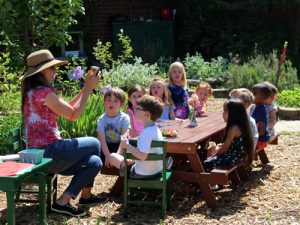
Sara Stratton leads Primary students in making dressing for their strawberry spinach salads.
Springtime is always joyful in Greensboro Montessori School's organic gardens. Winter buds swell and burst, capturing the eyes and hearts of community members, no matter their age! Flowers of all kinds call to us and to our pollinator friends, and sooner than we realize, we reach the height of the season.
This year brought a colder and wetter forecast than in the past. We’ve still yet to harvest our first sugar snap peas, but the strawberries and spinach are out with a vengeance! We continue to enjoy the lushness all the early rain and cool weather brought, even as temperatures rise. Here’s a brief update from our spring adventures!
Primary and Lower Elementary have enjoyed plenty of weeding, watering, planting, and tasting. We just finished a week full of strawberry spinach salads, with a bit of fennel and spring onions thrown in for fun! (Check out the recipe below if you’re interested in trying this at home.) In Upper Elementary, we celebrated the conclusion of our Student Climate Change Summit art exhibition with a persimmon-ginger-honey ice-cream party! Everyone agreed it was fun to make and even better to taste!
Thanks to everyone who attended our Spring Community Garden Workday in the Primary Garden. Together, with roughly 20 volunteers from our school community (ranging in age from 18 months to 70 years old!), we had a blast and accomplished a swath of projects:
- A group of students and dads built a blackberry trellis.
- Sara Stratton supervised several painting projects: our new fence, sink, and picnic tables got all glammed up in a matter of minutes!
- Another dad mixed concrete, which every child who came to the workday used to make a decorative stepping stone.
- Nearly everyone weeded, watered, snacked, swept, and generally left the space looking wonderful for the students, faculty, administration, and all the special guests we welcome in the spring!
What else have we been up to in the organic gardens this spring? We have been incredibly blessed with the generosity of The Fund for GMS. You may have noticed several new Adirondack chairs, benches, swinging benches, outdoor sinks, and chalkboards in all three of our organic gardens. We also have a new Lower Elementary toolshed coming soon. The students have relished in these new additions to their outdoor classrooms, and we couldn’t be more grateful to have such gifts shared with us from within our school community. Thank you, for your continued support of environmental education at Greensboro Montessori School. From all of us on your environmental education teaching team, Happy Spring!
Strawberry Spinach Salad
For the salad:
- 1 pound fresh spinach, washed and spun
- 1 pound fresh strawberries, washed and dried
- 2-3 spring onions, optional
- 2-3 leaves fennel, minced
For the dressing:
- 1/4 cup olive oil
- 1/8 cup balsamic vinegar
- 1 tablespoon honey
- 1 pinch cinnamon
 About the Author
About the Author
Eliza Hudson is Greensboro Montessori School's lead environmental educator. Eliza holds her bachelor's degree in biology from Earlham College in Richmond, Ind. She has built and tended school gardens, taught hands-on cooking lessons and connected local farms to school programs working for FoodCorps. Prior to joining Greensboro Montessori School in 2014, Eliza was a classroom and after-school assistant at the Richmond Friends School, a farm intern at a family-owned farm in Ohio, and served as assistant director at a summer day camp in an urban community garden in Durham.
Greensboro Montessori School has taught environmental education since 1995 and has been permaculture gardening on its campus since 1997.
Greensboro Montessori School welcomes families from all cultures and ethnicities, with over 20 different languages spoken in our families’ homes and people of color representing 27% of our student population. The International Fair is an annual celebration of this rich diversity.
Organized and hosted by the Greensboro Montessori School Community Association (GMSCA), the 2018 International Fair is a two-week event, which kicks off on Monday, May 7. Community volunteers – students, parents, faculty, staff, and friends of the School – will share their native countries, cultures, and customs with students through individual classroom presentations. The specific countries about which our students will learn are Australia, Canada, Czech Republic, Egypt, France, French Polynesia, Ghana, India, Italy, Jamaica, Japan, Jordan, Lebanon, Pakistan, Panama, Romania, and Scotland. These presentations will run through Thursday, May 17.
The 2018 International Fair will conclude with an all-school assembly the morning of Friday, May 18. Our students will enjoy a robust program featuring:
- Internationally themed songs performed by Primary, Lower Elementary and Upper Elementary students
- Columbian folk dance presented by Upper Elementary students, led by Rossana Aranda, a member of our Spanish faculty
- Traditional dress exhibit highlighting South American cultures
- Guest performance by the Walsh Kelley School of Irish Dancing
- Unveiling of a collaborative student art project featuring expressions of peace
Our students, themselves, will also star in the assembly, as we invite them to wear traditional, cultural dress to school on Friday, May 18. Whether students want to share their personal cultural heritage through dress, or wear traditional clothes from a culture different from their own, we welcome all forms of cultural expression on this special day.
We look forward to a delightful two weeks commemorating our community's rich, cultural diversity and Dr. Maria Montessori’s commitment to peace education. Please ask your children to share what they’ve learned from their classroom presentations and visit our Photo Gallery in late May to enjoy the best moments from the International Fair.
Along with the revitalization of the Primary Classrooms that already happened in January, classroom grants are another big part of The Fund For GMS. The student-faculty-staff committee met over the winter and made decisions about the classroom grants funded by this annual drive, and we are now actively working on bringing those grants to fruition. With record-breaking parent participation and 100% participation from faculty, staff, and the board, we are delighted to announce our 10 grants from 70 in 70: The Fund for GMS. Each grant fits into one of three categories which organically emerged among the winners: Technology, Curricular Enrichment, and Outdoor Play.
Technology
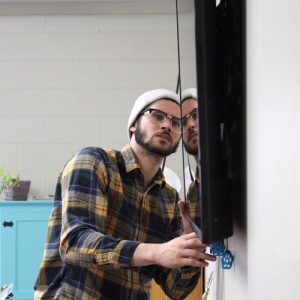
Greensboro Montessori School's director of information technology installs a new UHD TV in the Junior High language arts classroom.
Collaborative learning through technology: All of Greensboro Montessori School’s Elementary and Junior High programs, serving grades one through nine, now benefit from state-of-the-art projection systems. In addition to our five existing SMART Boards, we now have six new mounted 55” ultra-high-definition (UHD) televisions, each accompanied by Apple TV 4K units. This technology system allows for wireless sharing and projection of educational programming from the School’s suite of MacBook computers and iPad devices. In addition to serving students, the systems can be used for staff meetings, parent gatherings, and other functions.
Real-time science demonstrations: Last fall our seventh- and ninth-grade students visited the Duke University Marine Laboratory where they spent hours of their own volition using a microscope which broadcasted to a high-definition television (watch the video of their fun here). Everyone in the classroom could view what was being seen under the microscope with breathtaking clarity. This system is now installed in our science laboratory, along with a new set of six high-quality dissecting microscopes which were recently used for shark dissection in Upper Elementary.
Functional technology in Lower Elementary: Our Lower Elementary classrooms are the beneficiaries of a charging station for their iPad devices and a shared printer. Prior to this technology grant, students using the School’s Read&Write literacy software had no access to print their work. Hence, teachers had to transfer and print any work done by students in the administrative office. With their own printer, students can independently complete their work which maximizes the benefit of their software.
Curricular Enrichment
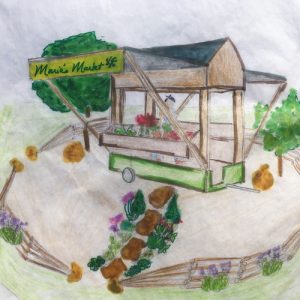
A permaculture design sketch of the permanent home for Maria's Market.
A permanent home for Maria's Market: Junior High students at Greensboro Montessori School have multiple opportunities to delve into the study of economics through entrepreneurial experiences in both individual and group projects. Through their careers program, Students operate a micro-economy, which includes finance; management (student council), farming; culinary arts (restaurant); research, design and production; and yearbook. Farming, more casually called the farm team, is in charge of harvesting produce and eggs which they sell to restaurant for profit. Through a venture called Maria’s Market, they also sell to the public. A grant from The Fund for GMS will create a permanent home for a farm stand (which was built by the research, design, and production team) from which Maria’s Market will be open for business on select Friday afternoons.
Creativity on display: In a recent blog post about our Music Ensemble program, Upper School faculty, Jonathan McLean, noted how the daily integration of the arts is “something vitally different that we do here at Greensboro Montessori School.” A new gallery-style art hanging system in the Upper School will give creative works a new way to shine. The professional display system will further elevate art programming and pave the way for formal exhibitions in the future.
More functional (and beautiful) outdoor classrooms: In The Secret of Childhood, Dr. Maria Montessori writes: “There must be provision for the child to have contact with nature, to understand and appreciate the order, the harmony and the beauty in nature… so that the child may better understand and participate in the marvellous things which civilization creates.” Our permaculture gardens are one of the primary ways our students interact with nature, and recent investments made possible through The Fund for GMS have greatly enhanced these spaces. Chalk boards provide a space for displaying messages, lessons, and recipes. Scattered Adirondack chairs encourage small group work and reflection. A fence panel gracefully hides the HVAC units. And, a child-accessible tool shed in Lower Elementary builds students’ confidence, independence, and efficiency.
Outdoor Play
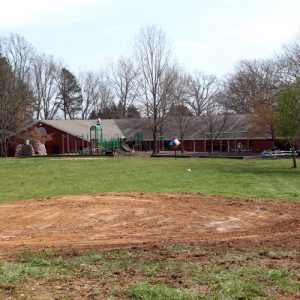
The leveled site for the Gaga Ball Pit, looking back over the athletic field toward the Upper School.
Going gaga for Gaga (Gaga Ball, that is): The Montessori method promotes physical movement as a path to improved mental cognition. It’s no wonder our Upper Elementary students are clamoring for a Gaga Ball pit, and thanks to The Fund for GMS, they will soon have one. The Gaga Center in New York City describes Gaga as “a fast paced, high energy sport played in an octagonal pit … Dubbed a kinder gentler version of dodgeball, the game is played with a soft foam ball, and combines the skills of dodging, striking, running, and jumping, while trying to hit opponents with a ball below the knees. Players need to keep moving to avoid getting hit by the ball. Fun and easy, everyone gets a serious workout.” Greensboro Montessori School’s Gaga Ball pit will be installed near the center of campus, nestled between the athletic field, Lower Elementary garden and Primary CASA playard.
Increased accessibility to soccer: We’ve replaced our outdated, tremendously heavy soccer goals with contemporary goals featuring 4-inch round aluminum uprights and crossbar with a white powder-coat finish. Not only are these goals durable and cleanly designed, they are easy to move making soccer more accessible to students and extending the life of our athletic field. Rather than taking the goals down immediately following the soccer season to protect the field, we can easily relocate the goals to the side line. This move shifts shooting away from the 18-yard box (the high traffic area around the goals) and allows Primary and Elementary students to continue using the goals well into fall.
Keeping sand in its place: The Tod Squad, as our Toddler faculty are affectionately called on campus, noticed their sandbox experiencing recurring issues with large quantities of mulch and rainwater flooding into the area and covering the sand. They requested wooden edging around the perimeter of their sandbox to preserve the longevity and quality of the sand (and the Toddler’s sand work, in general). This edging has already been installed, and our youngest students love their enhanced space.
Growing a vine tipi in Toddler: The Toddler play yard is full of fun, but also lots of sun. By berming up the perimeter around the Toddlers’ bamboo tipi, our environmental faculty can train some vines onto it, thereby creating a natural, shaded area for the students to play in and enhancing the beauty of our play area. Annual vines will be planted first, and more hardy, permanent perennials will be planted next.
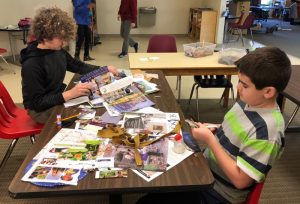 What do you love in the world and think is worth preserving?
What do you love in the world and think is worth preserving?
Upper Elementary students wrestled with this important question during their class project for the Green and White Bash silent auction. My daughter, Stella, is a student in the Upper Elementary classroom, and I was privileged to assist the children in transforming two blank puzzles into a lively mixed media college. Since the Bash’s theme was “sustaining our future” through the funding of student scholarships and staff professional development, I thought it would be fitting for the class project to address this idea of sustainability. So, I asked each student to design a single puzzle piece that identified their own personal junction of love and preservation. All the pieces joined together to form a single, unified collage.
The project turned out to be both intellectually and artistically challenging for the class. Some of the students needed clarification on the question and took extra care to reflect on the conceptual differences among sustainability, preservation, and conservation. Others thought of multiple ideas and found it hard to choose a single focus for their piece. They would sit in thoughtful silence, rifle through magazines for inspiration, or simply run off to do something else, planning to return later. For other children, the process was easier and they settled into their work instantly. Regardless of how quickly their work progressed, it was humbling to witness the moment when each child’s idea clicked into place. You could sense the wave of clarity and purpose wash over them as they set themselves to task. They would sift through the huge pile of assorted collage papers and magazines and dig through buttons, cork, sequins, pom pom balls, threads, beads, and other odds and ends to find the perfect color, texture, or imagery to convey their idea.
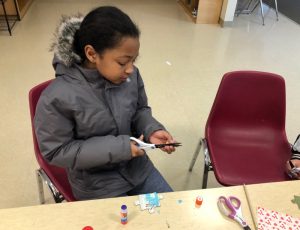 The students’ approaches to composition varied as dramatically as their themes. Some enjoyed working very flat, while others preferred a more 3D composition. Some students chose clipped images and text, while others wanted to incorporate their own drawings. Some designed beautiful miniature scenes of forests and picnics, while others worked more conceptually and built up layers of interest. Each piece was transformed into a unique and carefully crafted work of art.
The students’ approaches to composition varied as dramatically as their themes. Some enjoyed working very flat, while others preferred a more 3D composition. Some students chose clipped images and text, while others wanted to incorporate their own drawings. Some designed beautiful miniature scenes of forests and picnics, while others worked more conceptually and built up layers of interest. Each piece was transformed into a unique and carefully crafted work of art.
After the last student finished, I packed up all of the supplies and took everything home to (literally) put the pieces together. As I assembled the individual pieces into a finished collage, I was amazed by how well the variety of themes and designs worked together. Thirty-seven distinct responses to a single question had morphed into a microcosm of our beautiful, crazy modern world. Elements of nature (birds, oceans, trees) wove through interpretations of social life (family, friends, holidays) and modern living (technology, medicine, Disney). The Upper Elementary class project about sustainability had become an ecosystem of gratitude and hope for the future, where nature merges seamlessly with people, technology, and traditions: very much like a day at Greensboro Montessori School!

 About the Author
About the Author
Gina Pruette is a parent and regular substitute teacher at Greensboro Montessori School. In addition to her commitment to the School, Gina is an active volunteer within the greater Piedmont Triad community where she leverages her expertise in marketing and events planning, fundraising, and tech solutions to further the missions of various nonprofit organizations. Gina recently completed Racial Equity Training through the Racial Equity Institute to strengthen work with diverse populations, and she holds a bachelor of arts from the University of Pennsylvania.
Greensboro Montessori School's mission is to nurture children to be creative, eager learners as they discover their full potential and become responsible, global citizens.



